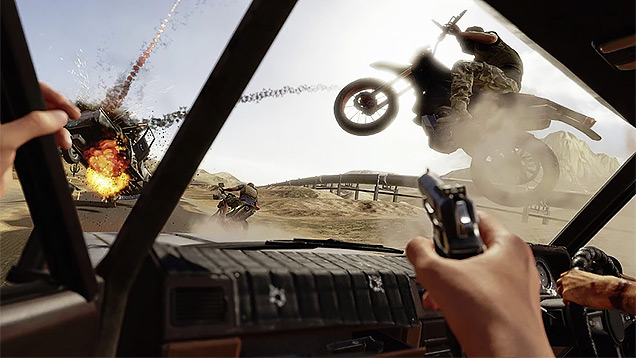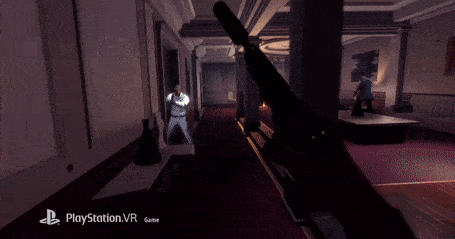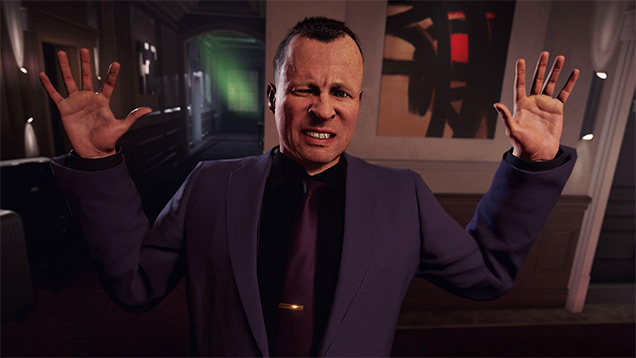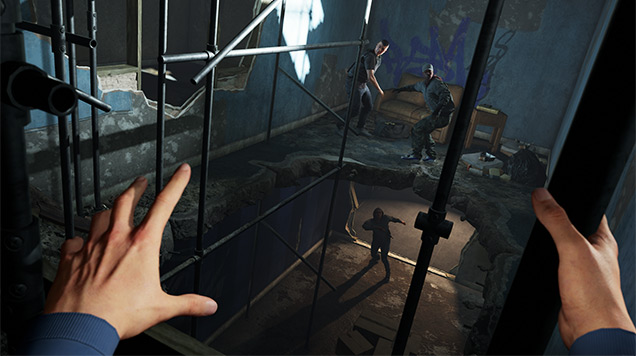Is Blood & Truth the most cinematic VR experience yet?

The recently released VR game Blood & Truth has been described by many pundits as an intensely cinematic experience. The most exhilarating action ‘movie’ of the year might not actually be a movie at all, says Luke Buckmaster.
Some writers have compared the pulse-pounding spectacle of Blood & Truth to the oeuvre of British filmmaker Guy Ritchie, whose early work is synonymous with sassy British crime pics. The most obvious similarities are the London settings and assortment of heavily armed, cockney-sounding nogoodniks. But this kinetic experience, which is available on PSVR and was inspired by the popular The London Heist mini game from PlayStation VR Worlds, is cinematic in ways that go far beyond characters and locations.
It comes pressure-packed with visual largesse and balls-to-the-wall spectacle, that’s for sure, from intensely visceral car chases to ‘bullet time’ moments that slow down the pace and ramp up the gunplay. More than one high octane sequence culminates with the player falling through the air from extreme heights; I was reminded of a skydiving sequence from Rodert Rodriguez’s VR film The Limit, during which I contemplated the possibility of witnessing the return of my breakfast.
Blood & Truth’s connection to cinema was made by the creators themselves, marketing the experience as “a hard-hitting shooter with all the explosive action and drama of a Hollywood blockbuster.” The pundits have agreed with that definition, to say the least, one describing it as “a playable action movie packed with guns, grime and gangsters.” It offers “a chance to dive into a Hollywood action movie,” said another, drawing comparisons to the bullet-riddled balleticism of auteur John Woo. Another described the production as one that “succeeds in allowing you to be the action movie star you’ve always wanted to be.”

The point, perhaps, is that the most exhilarating action ‘movie’ you’ll see this year is not, at least by conventional definitions, a movie at all. In a world in which the cinema landscape is fundamentally changing, with the proliferation of streaming services belonging to what some believe is the greatest content shift in Hollywood history, the increasingly prevalent attitude among the hoi polloi seems to be: it’s all just visual content. Virtual reality experiences are both a part of that – built with storytelling languages borrowed from film and video games – as well as being something strikingly different: a genuinely new artistic medium.
In Blood & Truth the player jumps into the skin of Ryan Marks, an ex SAS soldier belonging to a family of gangsters. The narrative involves a power grab by East End goon Tony Sharp (played by Steven Hartley, who is mocapped, like the rest of the cast) after the death of Ryan’s – that is, your – father. You spend a considerable amount of the running time with your brother Nick (Jay Taylor), who picks you up from the airport and takes you into town in his convertible. Nick is smoking a vaper while driving, which you can toke on yourself: if you exhale smoke will appear, the headset registering breath through its microphone.

The first car chase is the grand finale of an introductory segment involving the rescue of a fellow soldier from a compound in Afghanistan. Just as the early history of cinema is part and parcel with motion and vehicles, the most famous example being the Lumière brothers’ footage of a train arriving at a station, so too, to a certain extent, is modern VR. Most headset owners have learned to ignore the never-ending supply of gimmicky experiences involving rollercoaster and helicopter rides, for instance, which tend to be low-rent kinds of content. But there are finer examples too – such as the excellent Oscar-nominated 2016 film Pearl, which is based entirely inside a car and explores, without the cheesiness implied by the following words, a metaphor about traveling down the road of life.
It is perhaps no surprise that Blood & Truth accelerates (no pun intended) during its car chase scenes, which are thrillingly immersive. With the user stationary and the world outside whizzing by, this is one of the key configurations of the virtual bubble as outlined by the academic Laurent Lescop in Narrative Grammar in 360 – with the audience fixed and the virtual bubble moving. That setup works particularly well in Blood & Truth, partly part because shotgun-riding car chase scenes are hands-only affairs, which suits this game to a tee. The creators have searched for activities to keep your hands busy, in order to distract from the game’s limited node-based navigation, which restricts the player to gliding between predetermined location points rather than allowing freedom of movement.

The shooting is broken up by activities such as lockpicking and climbing, which, with PS motion controllers, work well – memorably evinced in a spectacular set piece involving the rescue of a family member from a building about to be demolished. Wouldn’t you know it: the demolition occurs while you’re still inside, and very high up for that matter. Here the level/set design is detailed and impressive, the integration of climbing part of an effort to broaden the experience out from mayhemic gunplay, which (despite imperfect readings from the motion sensors, resulting in occasional frustrations) is the game’s most purely enjoyable element. Another of these mixed-purpose integrations involves a nightclub-set shootout. Here you, now DJ Marks, can mix beats and spin discs while spraying bullets at cronies.

But the moment that keeps rumbling around my mind fascinates me not because of its spectacle – and it is immensely spectacular – but because of its temporal qualities. Falling, again, from a high up place, this time with a parachute, the game parallel cuts from an eerily beautiful fire and debris-filled skyline to a bittersweet moment involving the smiling face of a loved one holding up family photographs. Alone in the sky during one existential moment, contemplating your place among the stars in a very literal way, then in a kind of emotional solace the next, hit by the visualisation of a memory.
In traditional film it took a long time – an entire generation – to realise how time could be manipulated, and to refine the tools through which this is achieved, including flashbacks, flash forwards and parallel cutting. We are only just beginning to see how those techniques look when applied to concepts unique to VR (or at the very least concepts revitalised in this space) such as virtual presence and immersivity. The newness of the VR medium, coupled with the familiarity of the many genre tropes at play in Blood & Truth, creates contradictory feelings. Old but new. Unique but familiar. Fresh but cliched. It’s a movie, but it’s not.
Blood & Truth is now available on PlayStation VR.











